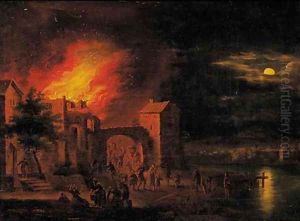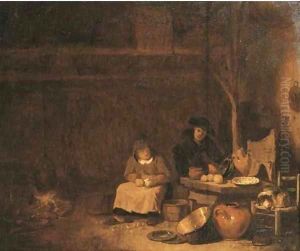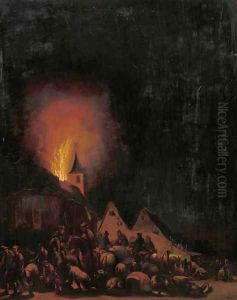Egbert Lievensz. Van Der Poel Paintings
Egbert Lievensz. van der Poel was a Dutch painter known for his depictions of nocturnal scenes, fires, and the effects of light. Born in 1621 in Delft, Netherlands, he was part of the Dutch Golden Age of painting, a period that is renowned for its wealth of artistic talent and innovation.
Van der Poel's early life remains somewhat obscure, but it is believed that he was initially taught by his brother, Lieven Willemsz van der Poel, who was also a painter. Later on, Egbert may have been a pupil of the more famous Aert van der Neer, who was known for his nighttime landscapes and winter scenes. Van der Poel's works often featured similar subjects, suggesting the influence of his supposed teacher.
Throughout his career, van der Poel displayed a keen interest in the interplay of light and shadow, which he explored through various subjects. However, he is particularly remembered for his paintings depicting the aftermath of the Delft Explosion of 1654, when a gunpowder magazine in the city exploded. His works meticulously portray the tragic event's destructive impact on the cityscape of Delft. These paintings are notable for their detailed rendering of the ruins and for capturing the somber mood following the disaster.
Van der Poel was also adept at painting more tranquil scenes, such as village landscapes and winter scenes with skaters on frozen waterways. His ability to render different light effects, from the glowing embers of a fire to the soft luminescence of a moonlit night, was remarkable and contributed to the enduring appeal of his work.
Van der Poel lived and worked in Rotterdam for the majority of his life, where he was a member of the Saint Luke's Guild. His works were collected by patrons in the Netherlands and beyond, reflecting the wide appreciation of his skill during his lifetime.
Egbert Lievensz. van der Poel passed away in 1664 in Rotterdam. His legacy is represented in various important art collections, including the Rijksmuseum in Amsterdam and the National Gallery in London. His contributions to Dutch landscape painting have cemented his place as a respected figure within the Dutch Golden Age. His exploration of light and careful documentation of a significant historical event in his hometown of Delft has left a lasting impact on the history of art.


